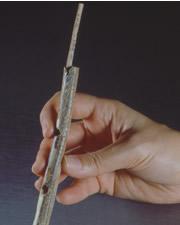 The flute has been reconstructed from 31 ivory fragments.© H. Jensen, University of Tübingen
The flute has been reconstructed from 31 ivory fragments.© H. Jensen, University of TübingenOne of the world's oldest known musical instruments has been discovered by German archaeologists. The 18.7-centimetre-long flute, which is carved from mammoth ivory, has three finger holes and would have been capable of playing relatively complex melodies.
The flute was found in 31 pieces in the Geißenklösterle cave in mountains near Ulm in southern Germany. Two other flutes made of swan bones were discovered at the site more than a decade ago. The three are much older than any other musical instrument yet discovered.
Nicholas Conard from the University of Tübingen, Germany, and his colleagues report the find in the latest edition of the Archäologisches Korrespondenzblatt1. They dated the age of the deposits where the three flutes were found to between 30,000 and 37,000 years old.
But it is the extraordinary sophistication of the newly discovered instrument that sets it apart from the swan-bone flutes. "This third flute is like a Rolls Royce compared with a Hyundai," says Conard. Its makers used mammoth ivory, the highest quality material available to them at the time, he says.
Carving a flute from solid ivory is much more demanding than making a flute from bird bones, which are already hollow. The crooked mammoth tusk had to be split and the two halves carefully hollowed out, then bound and glued together along a perfectly airtight seam.
Ivory adepts
<mediar rid='m1'><?xm-replace_text {mediar}?></mediar>The flute's makers lived in the Upper Palaeolithic era of the last ice age, a period when Europe was occupied simultaneously by the last Neanderthals and the first modern humans.
The inhabitants of the region were adept artisans, and small ivory figurines, which are among the earliest known examples of figurative art, have been found in several sites. Southern Germany "may have been one of the places where human culture originated", says Conard.
A few fragments of the Stone Age flute are missing, but to investigate what kind of music the instrument would have made, Friedrich Seeberger, an expert in prehistoric music and co-author of this report, has made a replica in elder wood.
His early experimentation suggests that the old flute would have allowed a relatively sophisticated level of musical variation. "The tones are quite harmonic," he says. They don't seem to follow a diatonic scale, he notes, but rather the rules of the pentatonic scale that predominates in Asia.
Seeberger now plans to build a more accurate replica, to hear exactly what the original flute would have sounded like. He is currently seeking the right material: mammoth ivory, of course.
